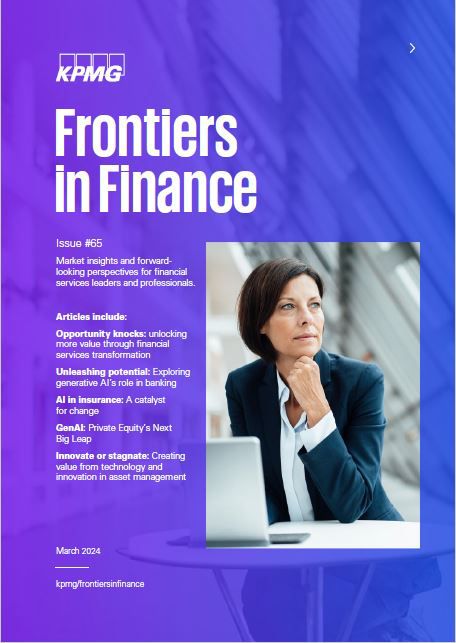Author: Paul Henninger, Head of KPMG Global Lighthouse, and Head UK Connected Technology, Partner, KPMG in the UK.
In the KPMG global tech report 2023, which is based on a survey of 2,100 executives in 16 countries. and nine different industries, most of the financial services executives say that their businesses have boosted performance and profitability over the past 24 months thanks to digital transformation. They say that the greatest improvements have come from investment in data and analytics and anything-as-a-service (XaaS) tools.
Frustrations flare in certain performance gaps
But financial services lags behind in places. In comparison to the average across all sectors surveyed, the financial services industry is less likely to have seen gains from some of its investments:
- 40 percent of financial services companies have not yet seen any increase in performance or profitability from their investments in cyber security initiatives over the last two years.
- 43 percent have not yet seen any increase in performance or profitability from their investment in low-code and no-code innovation in the last 24 months.
According to Paul Henninger, Head of Connected Technology at KPMG in the UK, many financial services companies are at a crucial stage of digital transformation journeys. "The sector is in a very strong position, having invested heavily in technology over the past five years, but this is also a moment of potential frustration," says Henninger. “Firms have modernized and are now running on top of a more contemporary set of technologies, but this has not resulted in a spontaneous change of their businesses — there is still work to do complete the change required to realize the value of all of this new capability."
Henninger suggests that to secure greater value from all areas of technology investment, financial services companies now need to articulate or re-articulate exactly what their business goals are — a transformed experience for customers, say, or the launch of new products and services. “Now that we can see how these contemporary technologies work, we can understand what our strategy is going to be,” he says. “There is an opportunity for excellent financial services leaders to decide what is important for how the business is going to run, and then to harness all this capability behind that strategy.”
Employee productivity is the top digital transformation prize
Workforce participation will be a crucial part of any strategy to make the most of new technologies. The financial services executives in KPMG’s research say that increasing employee productivity is the top reason to launch digital transformation projects. Many in financial services have already seen good results. The relative majority (46 percent) of financial services executives in the research say that improvements in employee productivity generated by recent digital transformation investments have exceeded their expectations. And 45 percent report greater-than expected improvements in employee satisfaction, which could give them a critical advantage in today’s battle for talent in the sector.
Financial services companies now need to build on these results by putting their people at the heart of innovation. Reducing costs by improving productivity without a plan to generate new value is likely to lead to job losses. Instead, technology driven increases in productivity should free up the sector’s workforce to focus on creating new value.

Many are placing their bets on quantum computing
Emerging technologies have the potential to also open up new routes to greater success. Financial services companies are particularly excited about the potential of quantum computing — they now see it as a top-three technology priority for investment. Across all the sectors surveyed by KPMG, quantum computing fell outside the top three technologies needed for meeting short-term ambitions.
Many financial services businesses are seeing others in the industry pressing ahead with quantum computing investment and are trying to catch up: 56 percent are prioritizing this technology because leaders in their market have already embraced quantum computing.
The accelerated processing speed provided by quantum computing allows financial services businesses to make better use of data and analytics tools and build on their early experiments with artificial intelligence (AI). Complexity in areas such as investment decision making has limited the implementation of AI tools, but the speed at which quantum computers can work through even the largest and broadest datasets will unlock new opportunities to automate complicated tasks.
So far, the sector’s use of quantum computing has been relatively low-key. Proof-of-concept work in distributed networks and cryptography is under way at banks, and investment managers are starting to use quantum computers in areas such as the back-testing of performance indices.
Henninger predicts that these initiatives will now proliferate and accelerate. “Speed can change everything,” he says. “Quantum computing is one of the technologies that in terms of magnitude of impact is most likely to change the world.”
The challenge for the financial services sector will be to harness that potential to drive innovation —and to finally achieve the business model upgrades promised by digital transformation plans.
To set you on the right path here are three suggestions for how financial services business can move further forward with digital transformation:
- Patch up performance gaps through intentionally targeted digital transformation. While many firms have updated their technology, in most cases, this has not fundamentally changed the way they do business. Having cleared out a bulk of their technology debt, the next stage is to put these new capabilities to work more holistically, closing any final gaps standing in the way.
- Focus on quantum computing initiatives for speed rewards. Quantum computing will hugely accelerate the speed at which financial services firms work, particularly as they look to harness their extensive data. This can help to open new use cases — for instance the launch of services that harness a combination of complex features in areas such as alternative investments, for example.
- Leverage productivity gains to drive value rather than just counting the cost savings. Improved productivity could enable reduced headcount, but firms will make bigger gains where they instead use freed-up resources to drive transformation of products and services. It will be important to recognize the economic impact of digital transformation on the organization in all respects, including the allocation of value, for example, transfer pricing purposes, to technology. Ultimately, the revenue gains for organizations that become true partners to their customers will dwarf the value of cost savings.

Frontiers in Finance: Issue 65
Market insights and forward-looking perspectives for financial services leaders and professionals.
Download magazine (1.9 MB)







